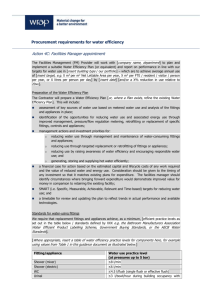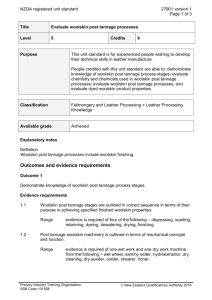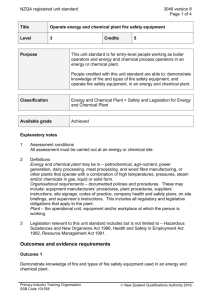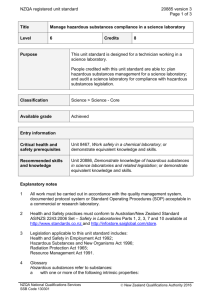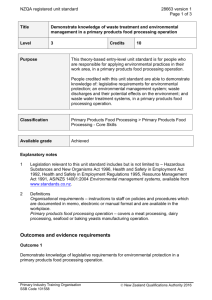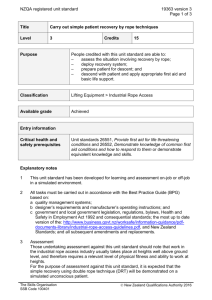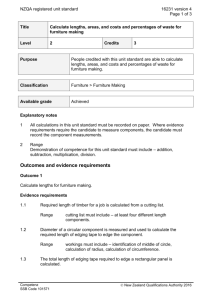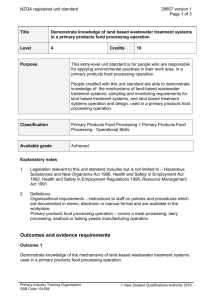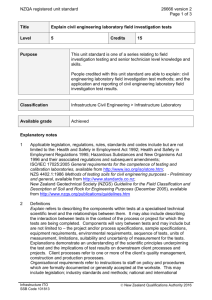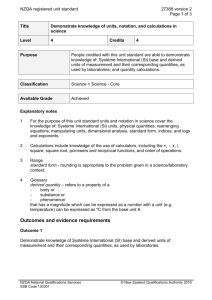17806 Demonstrate knowledge of protection from the harmful effects
advertisement
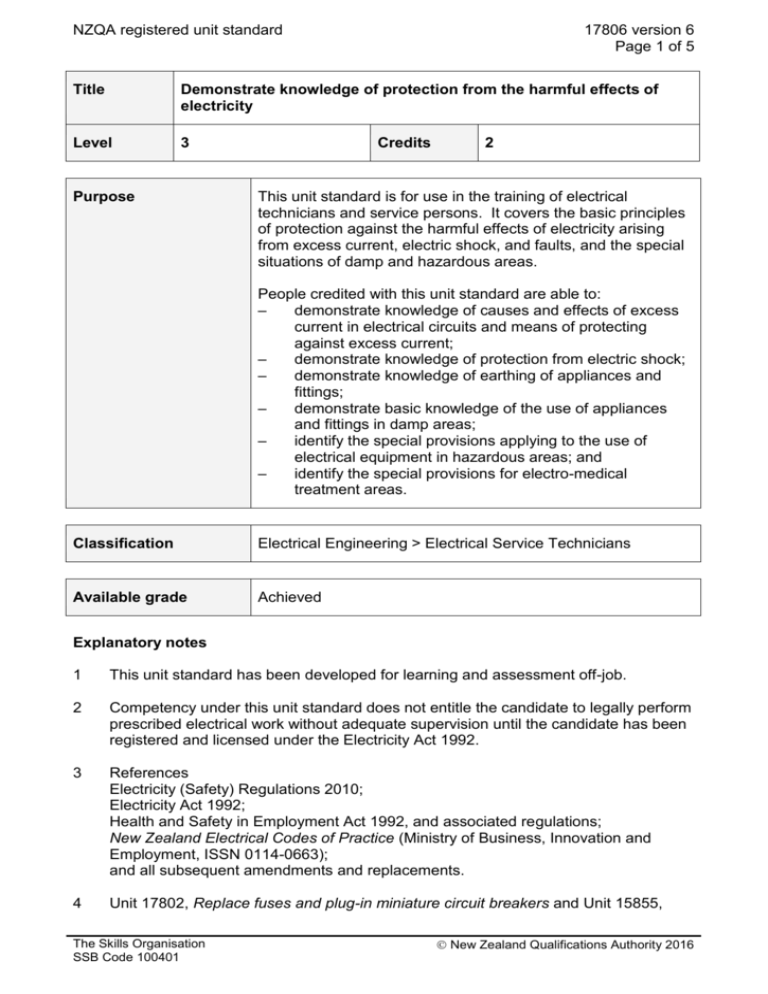
NZQA registered unit standard 17806 version 6 Page 1 of 5 Title Demonstrate knowledge of protection from the harmful effects of electricity Level 3 Purpose Credits 2 This unit standard is for use in the training of electrical technicians and service persons. It covers the basic principles of protection against the harmful effects of electricity arising from excess current, electric shock, and faults, and the special situations of damp and hazardous areas. People credited with this unit standard are able to: – demonstrate knowledge of causes and effects of excess current in electrical circuits and means of protecting against excess current; – demonstrate knowledge of protection from electric shock; – demonstrate knowledge of earthing of appliances and fittings; – demonstrate basic knowledge of the use of appliances and fittings in damp areas; – identify the special provisions applying to the use of electrical equipment in hazardous areas; and – identify the special provisions for electro-medical treatment areas. Classification Electrical Engineering > Electrical Service Technicians Available grade Achieved Explanatory notes 1 This unit standard has been developed for learning and assessment off-job. 2 Competency under this unit standard does not entitle the candidate to legally perform prescribed electrical work without adequate supervision until the candidate has been registered and licensed under the Electricity Act 1992. 3 References Electricity (Safety) Regulations 2010; Electricity Act 1992; Health and Safety in Employment Act 1992, and associated regulations; New Zealand Electrical Codes of Practice (Ministry of Business, Innovation and Employment, ISSN 0114-0663); and all subsequent amendments and replacements. 4 Unit 17802, Replace fuses and plug-in miniature circuit breakers and Unit 15855, The Skills Organisation SSB Code 100401 New Zealand Qualifications Authority 2016 NZQA registered unit standard 17806 version 6 Page 2 of 5 Demonstrate knowledge of circuit protection, deal with circuit protection against excess current in greater detail. 5 Definitions Current regulations and standards – refers to the requirements of the above legislation and standards, applied to the context in which the term is used. Electrical technicians and service persons – for the purposes of this unit standard means, people who hold or who are working towards electrical registration as an Electrical Service Technician, Electrical Appliance Serviceperson (endorsed to disconnect and connect), or Electrical Appliance Serviceperson. IP Code (Ingress Protection) – is a system for classifying the degrees of protection provided for electrical equipment. Outcomes and evidence requirements Outcome 1 Demonstrate knowledge of causes and effects of excess current in electrical circuits and means of protecting against excess current. Evidence requirements 1.1 Circumstances leading to excessive current in an electrical circuit are identified, and the likely effects stated. Range 1.2 circumstances – mechanical overload, phase to neutral short circuit, phase to earth fault current; effects – overheating, fire, damage to equipment, arcing. Commonly used devices to protect against excess current are identified and their operation explained in simple terms. Range devices – thermal cut-outs, rewirable fuses, high-rupturing capacity (HRC) fuses, circuit breakers. Outcome 2 Demonstrate knowledge of protection from electric shock. Evidence requirements 2.1 Mechanical means of protecting users from contact with live parts are stated. Range plastic and metal covers, double insulation. 2.2 Earthing or double insulation requirements for all exposed metal parts are described. 2.3 The danger of using electrical appliances without proper earthing or insulation in earthed situations is explained in the context of simultaneous contact with live parts and the earth, and at least five examples of earthed situations are given with reference to current regulations and standards. The Skills Organisation SSB Code 100401 New Zealand Qualifications Authority 2016 NZQA registered unit standard 2.4 Safety devices for use with portable appliances are stated, together with explanations of how they offer protection against electric shock. Range 2.5 17806 version 6 Page 3 of 5 residual current devices, isolating transformers. The essential features of double insulated appliances are explained from the point of view of how protection against electric shock is provided. Outcome 3 Demonstrate knowledge of earthing of appliances and fittings. Evidence requirements 3.1 The principle of earthing of metal parts of appliances and fittings is explained. Range reference must be made to – how the appliance is earthed, safety of personnel under fault conditions, need for low resistance of earth wires, operation of circuit protection devices. 3.2 With the aid of a diagram, the path of the fault current is traced for a phase to metal frame contact in an appliance. 3.3 The maximum resistance permitted between the exposed metal of an appliance and the earth pin of the mains plug is stated in accordance with current regulations and standards. 3.4 The term equipotential bonding is explained in terms of earthing and electrical safety, and with reference to current regulations and standards. Outcome 4 Demonstrate basic knowledge of the use of appliances and fittings in damp areas. Evidence requirements 4.1 The need for special treatment in wet or damp areas is explained in terms of safety to people and equipment. 4.2 The term damp situation is defined in accordance with current regulations and standards. 4.3 The purpose of the IP code is stated, and the meanings of three given codes are interpreted with reference to supplied tables. 4.4 The concept of zones in damp areas is explained, with reference to the effect this has on the use of appliances and fittings. 4.5 The importance of matching IP codes when making like-for-like replacements of fittings is explained. The Skills Organisation SSB Code 100401 New Zealand Qualifications Authority 2016 NZQA registered unit standard 4.6 17806 version 6 Page 4 of 5 Methods of protection from electric shock when using appliances in damp areas are identified in accordance with current regulations and standards. Outcome 5 Identify the special provisions applying to the use of electrical equipment in hazardous areas. Evidence requirements 5.1 The term hazardous area is defined with reference to explosive atmospheres and the need for special precautions in the construction, installation, and use of electrical equipment. 5.2 Typical hazardous areas are identified. Range typical areas – petrol and CNG/LPG service stations, spray booths, petro-chemical plants, oil platforms, coal mines, flammable materials stores, laboratories; at least three are required. 5.3 The classifications of hazardous areas and of electrical equipment for use in hazardous areas are explained in simple terms. 5.4 The special requirements and procedures in relation to equipment, cabling, cable entry arrangements to fittings, and documentation are identified, and the need for special training on this equipment before attempting repair or replacement is stated. Outcome 6 Identify the special provisions for electro-medical treatment areas. Evidence requirements 6.1 Electro-medical treatment areas requiring special attention are identified. Range areas – body protected electrical areas, cardiac protected electrical areas, patient treatment areas, patient location, medical and dental practices. 6.2 The regulations and standards relating to electro-medical areas are identified. 6.3 Special requirements and procedures for use in electro-medical areas are identified. Range The Skills Organisation SSB Code 100401 requirements and procedures relating to – installation of appliances, maintenance, testing, documentation, training, and certification. New Zealand Qualifications Authority 2016 NZQA registered unit standard Planned review date 17806 version 6 Page 5 of 5 31 December 2014 Status information and last date for assessment for superseded versions Process Version Date Last Date for Assessment Registration 1 25 November 2000 31 December 2013 Revision 2 3 April 2001 31 December 2013 Revision 3 19 May 2004 31 December 2013 Review 4 20 June 2006 N/A Rollover and Revision 5 20 September 2012 N/A Revision 6 15 January 2014 N/A Consent and Moderation Requirements (CMR) reference 0003 This CMR can be accessed at http://www.nzqa.govt.nz/framework/search/index.do. Please note Providers must be granted consent to assess against standards (accredited) by NZQA, before they can report credits from assessment against unit standards or deliver courses of study leading to that assessment. Industry Training Organisations must be granted consent to assess against standards by NZQA before they can register credits from assessment against unit standards. Providers and Industry Training Organisations, which have been granted consent and which are assessing against unit standards must engage with the moderation system that applies to those standards. Requirements for consent to assess and an outline of the moderation system that applies to this standard are outlined in the Consent and Moderation Requirements (CMR). The CMR also includes useful information about special requirements for organisations wishing to develop education and training programmes, such as minimum qualifications for tutors and assessors, and special resource requirements. Comments on this unit standard Please contact The Skills Organisation reviewcomments@skills.org.nz if you wish to suggest changes to the content of this unit standard. The Skills Organisation SSB Code 100401 New Zealand Qualifications Authority 2016
